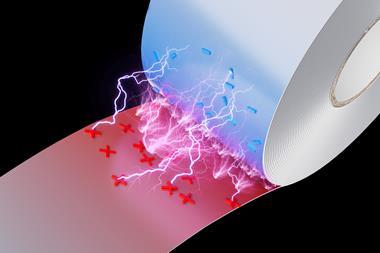The 2010 Nobel prize for physics went to Andre Geim and Konstantin Novoselov
The 2010 Nobel prize for physics went to Andre Geim and Konstantin Novoselov of the University of Manchester, UK, for what in essence is a clever piece of chemistry. Using Scotch Tape they isolated and studied a single molecular sheet of graphite - graphene.
Graphite itself, of course, is a 3D polymer like the cross-linked synthetic resin Bakelite. It is a rigid solid, insoluble in everything. By contrast, graphene has some interesting properties and Chemistry World (see April 2008, p56) has discussed the challenges of graphene, and its unusual electrical conductivity.
The 2010 Nobel prize emphasises a strange gap in polymer chemistry. 1D polymers, essentially long snaky molecules, are well-known. In industry polythene, PVC, polystyrene and so on, are made in millions of tonnes and in biochemistry long-chain proteins, and DNA itself, are intensely studied. 3D solid molecules are also well-known - from the giant ionic lattice of common salt, to the rigid atomic assemblies of Bakelite, diamond and indeed graphite itself. Yet 2D polymer molecules are practically unknown, either to nature or to chemistry. Graphene is about the only one.
However, there seems nothing impossible about a 2D polymer. A sort of molecular carpet or ribbon, it would need some sort of terminating ’fringe’ all round the edge, just as a 1D polymer needs two end-groups. The simplest 2D polymer might be graphane - a sort of 2D polythene made of cyclohexane rings in a hexagonal lattice.
On each carbon atom of graphane, a hydrogen atom sticks out of the sheet and so the molecule presents two hydrogen-rich surfaces to the space outside it. Graphane has been made from hydrogenating graphene (see Chemistry World, March 2009, p23) but in principle, you might make it by reacting graphite with hydrogen, saturating each carbon surface in turn to release a graphane molecule. Nobody seems to have made that reaction work and current methods only produce small flakes of graphane rather than large sheets.
It is easy to imagine variations on graphane - the 2D equivalents of PVC, polystyrene, and so on. What would such polymers be like? Would they be soft solids like their snaky one-dimensional equivalents? Or would they be rigid? Most intriguing of all, could they be melted? Could they be dissolved in anything? A solution of a 2D polymer might have quite non-intuitive properties - perhaps its viscosity would vary with direction, according to the orientation of the molecules in it. Any such solubility might depend strongly on the fringe round the molecular edge.
And what form would the dissolved molecules take up? They might spread out flat, like floating carpets. Or they might curl up like nanotubes. If so, what radius would they choose? They could dodge that challenge by folding up as cones. The resulting molecular agglomeration might even attract other carpet-molecules as a sort of wrapping. So a solution or melt could be very strange indeed and that could lead to novel applications in paints, adhesives, lubricants or coatings.
A 2D polymer could make an intriguing solid, too. You might be able to roll it out into a sheet, with all its molecules flat. If that sheet were as impermeable as metal, it would challenge the metal food-can and open up a vast market for packaging applications.
All this is a huge guess. Yet it seems to me that 2D polymers ought to exist. To make them in quantity, we must invent a trick new both to chemistry and to nature. That would transform the whole plastics industry!
David Jones












No comments yet